Tale of Two Diaries: Two Pieces of Incredible African American History Discovered 10 Years Apart!
Posted by Jessica Katz on
January 10, 2025 will go down in Katz Fine Manuscripts' history as a day of kismet, and the day we made a thrilling discovery!
In 2015, when this rare manuscript business was in the hands of its founder, Ben Katz, an incredible acquisition was made. Ben acquired a very special piece of Black American history, being the Dec 30, 1901-May 24, 1904 diary of Venecia Taylor, a Black (likely biracial) Jamaican woman who immigrated to the United States in the late 19th century and worked as a servant in the homes of white families in Wayne, Pennsylvania and New York. Sadly, when the diary arrived in the mail, Ben found it had been destroyed in transit. Recognizing that this piece of history was too vital to throw away, Ben contracted a well-known Toronto, Canada based Master Conservator, Rose Newlove of Newlove Bindery, to restore the manuscript.
late 19th century and worked as a servant in the homes of white families in Wayne, Pennsylvania and New York. Sadly, when the diary arrived in the mail, Ben found it had been destroyed in transit. Recognizing that this piece of history was too vital to throw away, Ben contracted a well-known Toronto, Canada based Master Conservator, Rose Newlove of Newlove Bindery, to restore the manuscript.
Once restored, the manuscript was acquired from Katz Fine Manuscripts (known back then as M. Benjamin Katz Fine Books/Rare Manuscripts) by Johns Hopkins University and currently sits in their collection of African American History and Culture.
On January 10, 2025, Ben's daughter, who now runs the business with her spouse, was organizing unlisted inventory and came upon a diary she had acquired in early 2024 from a New York-based collector who had not provided information on the diary's author. Somehow this diary had been left in the packaging it arrived in, never opened, assessed or researched once it reached the Katz Fine Manuscripts office. The purchase receipt simply read, "1904-1908 Diary".
The diary, which is extremely well-written (often poetically so) and which includes an impressive quality and quantity of entries, turned out to be Venecia Taylor's 1904-1908 diary. In fact, Taylor began this 'new' diary on May 29, 1904, only five days after she concluded the diary that Ben had restored and sold to Johns Hopkins nearly a decade ago.


- Ben's blog from the mid-2010s detailing the intensive restoration work completed in 2015 on Taylor's 1901-1904 diary which sits in Johns Hopkins collection today.
- The listing for Taylor's newly discovered 1904-1908 diary (click here!)
If you have any questions please do not hesitate to email as at info@katzfinemanuscripts.com or fill out the Contact Us form on our website .
Below is Ben's blog on the diary restoration, written in approximately 2017, in its entirety. You can read the original listing for this diary by clicking here.
- Thin, cloth, case bound account book (7 columns) used as a manuscript diary.
- “Day Book” printed in black on brown coarse linen covering material, stamped decorations in black ink upper and lower boards.
- “Venecia” in pencil on upper board.
- Book block and case are completely separated, front fly sheet is partially separated from the text at the spine; there is no fly sheet at the end of the text.
- Machine stitching and a secondary sewing incorporates 3 muslin sewing supports 2 of them separated from the text.
- Book block is lined for account record but used as a diary with entries in stable manuscript ink and pencil.
- Page numbers stamped in blue at fore edge, head corner.
- Margin lines are red and dark blue, water soluble ink.
- Botanical sample inserted, note inserted, 2 pinned fragments.
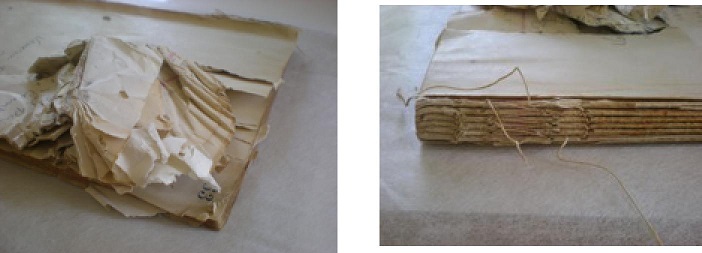
- Considerable damage to first 65 pages of text block due to shipping mishap - mechanical damage.
- Damage includes severe creasing, tearing, loss of paper & information, scuffing & skinning of paper.
- Separated cover has not suffered the mechanical damage and is out of scope for this treatment. Cover has distinct musty odour.
- Stitching is loose w/ stretched sewing holes and a few breaks in the thread.
- Lining of super has delaminated from text, still attached to boards under the pastedowns. Animal glue consolidating the spine has disintegrated, stains & some accretions remain.
- Last page 151/152 is almost completely separated. Its conjugate page 125/126 is also separated w/ damage at the head edge - this is old damage not related to the current issues.
- Spine folds of sections are split at head & tail - sections 1, 2, 3 and last section.
- Spine folds torn at several sewing holes of first sections.
- Goal of treatment was to make the contents accessible and as readable as possible.
- First 2 sections - pages disentangled and sections removed from sewing.
- Full sheet humidification; local humidification for damage in section 3, still sewn.
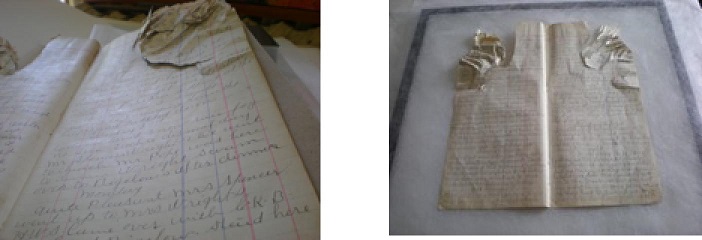
- Drying and flattening in blotter stack in standing press.
- Tears mended with 5 gm Tengu-jo, Kozo tissue, applied w/Jin Shofu (wheat starch paste).
- Mending strips applied generally on verso and occasionally repeated on the recto.
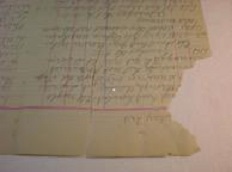
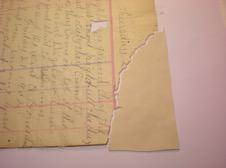
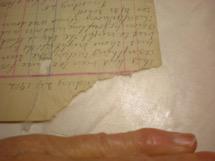
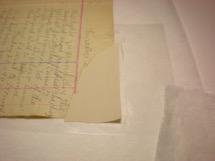
- Damaged areas of 3rd section were repaired in situ.
- Mended leaves dehumidified and flattened in standing press.
- Remaining sections disband; last page and its conjugate reunited with guard of Kurotani 16, Kozo, & Jin Shofu.
- Page 125 - mends to head of page w/5 gm Tengu-jo applied to both sides.
- Outer spine folds of sections mended as necessary, usually at head and tail.
- Stretched sewing holes and tears a sewing holes mended w/11 gm Tengu-jo.
- Title page reconnected to the 1st section with a “V” hinge of Kurotani paper.
- Sections resewn w/Barbour 25/3 linen thread, link stitched w/ no adhesive consolidation.
- 10 pt archival stock four flap folder provided to house the text block.
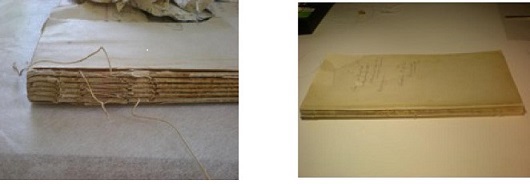
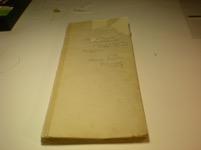
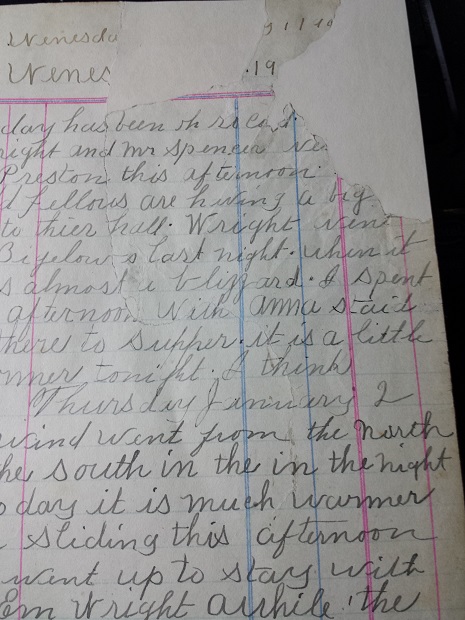
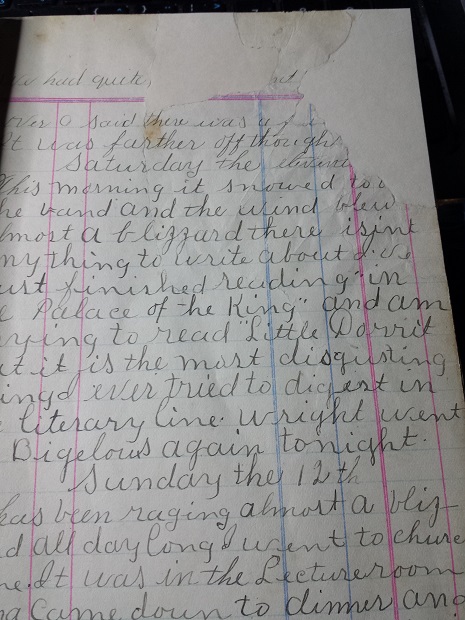
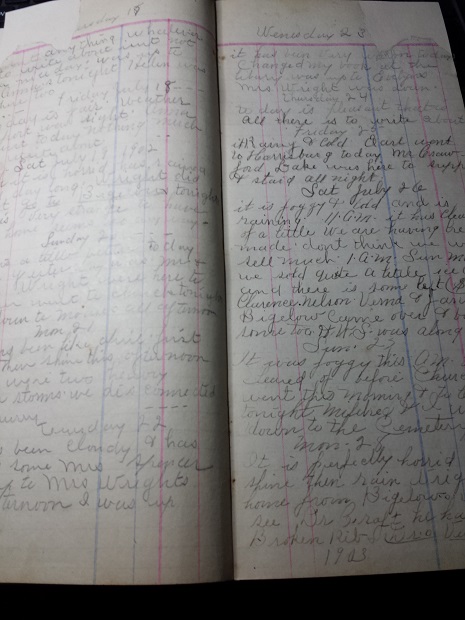

Share this post
- Tags: African American
